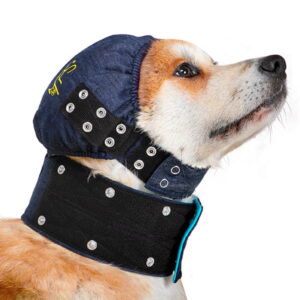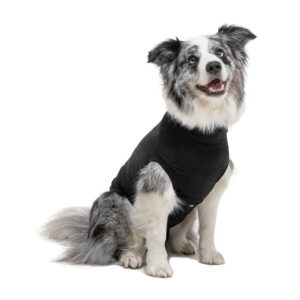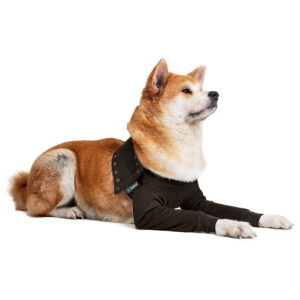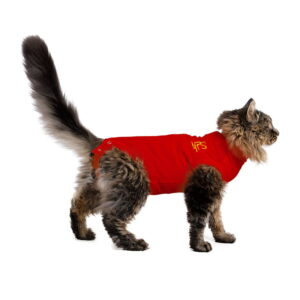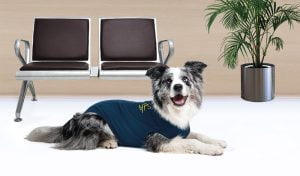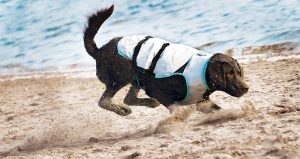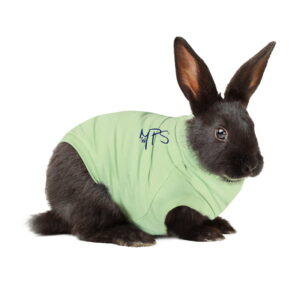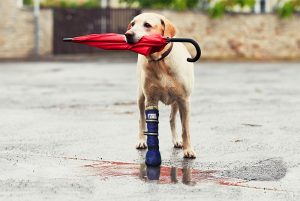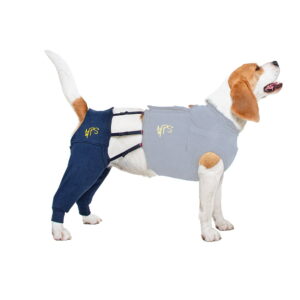Recovery Suit vs Cone: Testimonials and Case Studies from Real Pets
Considering an alternative to the cone? This page is your proof hub: real-world case studies, vet perspectives, and quick answers that help you choose confidently.
—
Featured quick answer: Is a recovery suit better than a cone?
Short answer: often, yes—especially for surgeries on the body (abdomen, chest, back) and for skin issues. Recovery suits protect wounds while allowing pets to eat, sleep, and move naturally, reducing stress. Cones can still be necessary for face/paw wounds or determined lickers/chewers. Many vets recommend using a suit first and keeping a cone as backup if your pet targets areas the suit can’t cover. Always follow your vet’s advice.
—
Why Recovery Suits Are Transforming Post-Operative Care
Traditional post-operative care for pets has often relied on rigid, plastic Elizabethan collars (“cones of shame”). While effective at preventing licking or biting at wounds, E-collars can cause stress, mobility issues, and feeding difficulties.
Modern recovery suits (Suitical for dogs, Medical Pet Shirts/MPS for cats) are a vet-approved alternative that prioritizes comfort, mobility, and wound protection—often reducing stress responses in pets.
Top reasons pet parents switch to suits:
- Comfort and mobility: pets can eat, drink, and sleep normally
- Reliable coverage: protects sutures and hot spots without blocking vision
- Gentle compression: can help calm anxious pets during recovery
- Hygiene and access: built-in toilet flaps for pee/poop without removal
- Washable, reusable: breathable, hypoallergenic fabrics
—
Are Recovery Suits Better Than Cones? Key Differences
- Comfort: suits allow normal eating/sleeping and reduce bumping into furniture; cones can cause frustration and anxiety.
- Protection: suits shield the torso, abdomen, and back. Cones better protect facial areas and paws.
- Compliance: many pets tolerate suits longer; some still need a cone backup if they persistently lick.
- Outdoor and toilet time: suits offer discreet coverage with quick-release flaps; cones can make toileting awkward.
- Skin care: suits prevent over-grooming, scratching, and keep topical meds in place longer.
—
Case Studies: Dogs and Cats Who Recovered in Suits
Case Study 1: Bella the Labrador – Post-Spay Recovery
Bella, a 12-month-old Labrador Retriever, underwent a routine spay. Her owner, Sarah, reported that Bella was highly anxious with the standard cone—she refused to eat or walk and struggled to sleep.
On day 2 post-op, Sarah switched Bella to a Suitical recovery suit. The difference was immediate. Bella resumed eating and walking, and her stress dropped noticeably. The gentle compression appeared to soothe her, and the fabric prevented her from licking the incision, which stayed clean and dry. Sarah’s veterinarian noted uncomplicated healing, with no need for extra antibiotics for self-trauma.
- What Bella wore: Suitical Recovery Suit for Dogs
- Sizing tip: measure chest girth and back length; if between sizes, choose the larger for comfort. See the Size Guide.
—
Case Study 2: Oscar the Domestic Shorthair – Skin Allergy Management
Oscar, a 6-year-old neutered male cat, has atopic dermatitis with constant licking and skin excoriations on his abdomen and hind legs. Topical treatments were prescribed, but Oscar licked them off quickly, reducing effectiveness.
A Medical Pet Shirt was used to protect newly treated skin and prevent self-trauma. The close fit helped keep the medication in place for several hours and reduced over-grooming. Within 10 days, inflammation subsided significantly, and Oscar’s coat began to regrow. After four weeks, his skin was clear and his behavior notably calmer.
- What Oscar wore: (MPS) for Cats
- Tip for cats: ensure snug (not tight) fit so the shirt stays in place; check daily for fur matting.
—
Case Study 3: Max the Dachshund – Back Surgery (IVDD) Rehabilitation
Max, a 5-year-old Dachshund, underwent spinal surgery for intervertebral disc disease (IVDD). Post-surgery care was challenging due to his long back and the risk of suture disruption.
Max’s vet team used a Suitical recovery suit to protect the surgical site. The adjustable, stretchy fabric avoided direct pressure on the spine and allowed gentle movement to limit muscle atrophy. The suit also supported physiotherapy sessions, including controlled range-of-motion work. Max recovered without wound complications and showed consistently low stress.
- Helpful for long-backs: Suitical for Dogs
- Consider a spare: having two suits simplifies daily washing and keeps protection consistent.
—
Vet Perspectives on Recovery Suits
“ I’ve integrated recovery suits into my routine surgical discharge protocols. Beyond eliminating the stress caused by cones, they reduce the number of recheck visits due to wound interference. Compliance with post-op care has improved significantly.”
“ Recovery suits offer tactical advantages in managing chronic skin conditions. Especially in patients with auto-traumatizing behavior, the suits shield skin and help keep topical treatments in place. My feline patients tolerate them particularly well.”
—
Scientific Backing: How Do Recovery Suits Work?
Recovery suits draw from pressure therapy and barrier protection principles:
- Gentle, even compression can stimulate calming tactile receptors, helping some anxious pets relax during recovery.
- Physical coverage prevents direct contact with sutures, dermatitis lesions, or medicated areas.
- Medical-grade textiles balance breathability with hygiene, supporting a clean micro-environment around wounds.
Always use recovery garments under veterinary guidance, especially after orthopaedic or spinal procedures.
—
How to Choose the Right Size and Fit
A good fit = better protection and comfort.
Measure chest girth (widest part) and back length (base of neck to base of tail).
Check your pet’s weight against the brand chart.
Between sizes? For most pets, size up for comfort; for sleek cats, a snug fit helps keep the shirt in place.
Breed notes: deep-chested breeds (e.g., Greyhounds, GSPs) may need to size for girth first.
—
How to Put On and Use a Recovery Suit
- Open all closures; gently guide the head and front legs through the openings.
- Align the back panel along the spine; fasten closures without over-tightening.
- For toileting, use the built-in flap (dogs) or loosen the rear panel (cats) and secure it away from the stream. Re-fasten afterward.
- Check twice daily for rubbing, dampness, or soiling; change into a clean, dry suit as needed.
Tip: Keep a spare suit so one can be worn while the other is in the wash.
—
Toilet Access and Hygiene (Micro-Guide)
- Dogs can pee and poop with the suit on by opening and securing the under-belly flap.
- Cats typically use the litter tray normally; fold or unclip the rear section as directed by the product tag.
- Keep the incision clean and dry; if the suit becomes wet or soiled, change it promptly.
—
Care and Washing (Micro-Guide)
- Machine wash cold or 30 °C, gentle cycle.
- Use mild detergent; avoid bleach and fabric softeners.
- Air dry flat away from direct heat.
- Wash before first use and whenever soiled. Owning two suits makes hygiene easier.
—
FAQs: Using Recovery Suits After Surgery
Can dogs and cats pee and poop while wearing a recovery suit?
Yes. Most suits include a toilet access flap (dogs) or a fold-back rear panel (cats). Open for toileting and re-fasten afterward.
How long should my pet wear a recovery suit after spay/neuter?
Typically 10–14 days, or as your vet advises. Keep the suit on whenever your pet is unsupervised to prevent licking or chewing.
Is it safe for my pet to sleep in the suit overnight?
Yes—when fitted correctly. Ensure the fabric is dry, breathable, and not too tight. Check daily for rubbing or moisture.
Will my dog overheat in a recovery suit?
Suits are breathable, but monitor in hot weather. Keep rooms cool, ensure hydration, and remove the suit briefly to air out if your vet says it’s safe.
Can dogs pee with a recovery suit on?
Yes. Open and secure the under-belly flap before going outside, then close it again afterward to protect the incision.
How many suits do I need?
We recommend two: one to wear, one to wash—especially for longer recoveries or dermatology cases.
How do I stop my dog licking stitches without a cone?
Use a well-fitted recovery suit that covers the incision. Supervise and combine with enrichment to reduce stress. Keep a cone as a backup if your dog is very determined.
What size should I choose for my breed?
Measure chest girth and back length, then consult the Size Guide. If between sizes, size up for most dogs; select snugger fits for sleek cats.
Is a recovery suit better than a cone for cats after spay/neuter?
For abdominal incisions, many cats tolerate a suit better than a cone because it allows natural eating and grooming while blocking access to the belly. Follow your vet’s instructions.
—
Share your story
Real recoveries help real pets. Send a photo and a short note (your pet’s name, procedure/condition, and which suit you used). We’ll credit you with consent.
—
Recovery suits are more than a fashion statement; they’re a thoughtful, vet-endorsed evolution in post-operative and dermatology care. With better comfort, easier routines, and fewer licking-related complications, they can make recovery calmer for both you and your pet.

